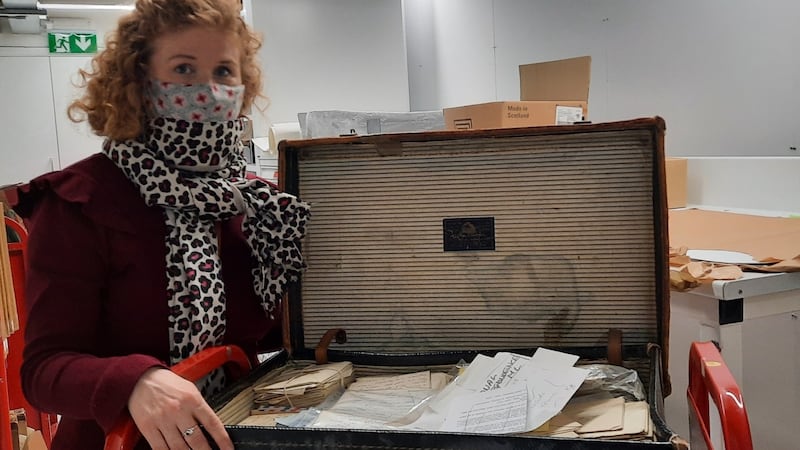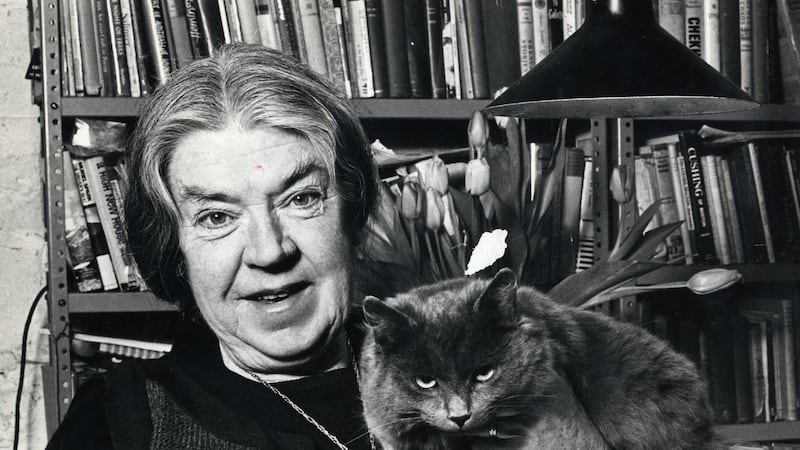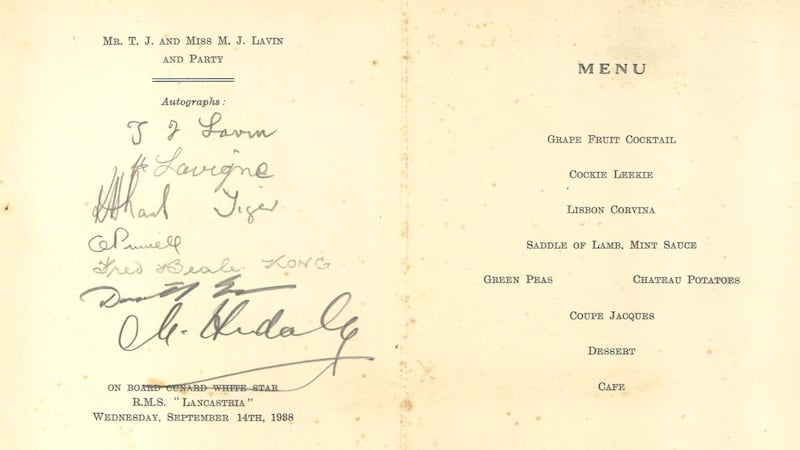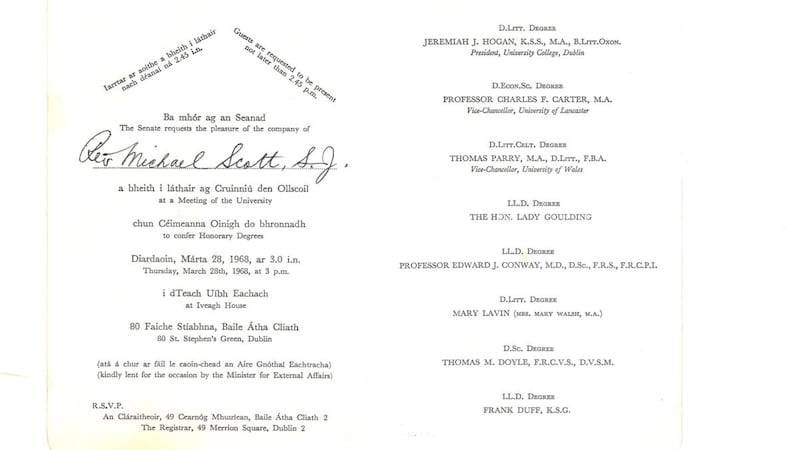Earlier this year an old, initialled steamer trunk, with accompanying boxes, was received by Evelyn Flanagan, head of special collections at University College Dublin. Its contents – the personal correspondence of writer Mary Lavin (1912-1996) – are a treasure trove.
In her will Lavin bequeathed to UCD Library her archive of literary manuscripts, including drafts of her short stories, and handwritten and typescript documents. This acquisition from the Lavin estate consolidates that very special collection and now sits beside literary archives from Maeve Binchy, Frank McGuinness, Edna O’Brien and Patrick Kavanagh.
In 1985 the acquisition of Kavanagh’s archive – and its preservation in Ireland rather than loss to the United States – was a cause célèbre, achieved in part by a public fundraising initiative led by the late Prof Gus Martin and which featured his appearance on The Late Late Show. Martin had been an early champion of Lavin’s work: in a long essay in the Irish Jesuit journal Studies in 1963 he challenged the critical neglect of her work, and wryly suggested that its reasons lay more in “the history of publicity than the history of literature”. In 2021 our purchase of the Lavin archive was made possible by alumni support provided to UCD Foundation’s Arts and Humanities College Support Fund and in particular the generosity of UCD alumnus Dr Joseph Hassett.


What light can papers such as these cast on the life and work of a literary writer? Lavin’s case is an especially important one, as a writer whose work moved in and out of public notice during her lifetime and since. She is now recognised as one of the greatest short story writers, but here national recognition has lagged well behind her international standing.
As the archive shows, her contemporary Eudora Welty identified Lavin’s distinctive talents in the early 1950s, some years before the beginning of Lavin’s long relationship with the New Yorker. That relationship – traceable through contracts, remittances and correspondence with editors Bill Maxwell and Rachel MacKenzie – emerges from these papers as one of the most vital in her literary career.
First collection
Lavin was born in 1912 in East Walpole, Massachusetts and was the only child of Nora Mahon and Tom Lavin. Unusually, Nora and Tom had met on a ship travelling home from America to Ireland but spent their early married years in the United States. When Mary was nine, her mother decided to return to Ireland and mother and daughter lived for a short period in Athenry before Tom’s return to Ireland. The family lived first in Dublin and then in 1930 in Bective, Co Meath, Mary’s home for much of her life.
She began her BA studies in English and French in 1934, receiving an MA in 1936. In an especially instructive tale for apprentice writers, Lavin famously ceased her doctoral research on Virginia Woolf by writing her first story, Miss Holland, on the back of a typed draft of her dissertation. The story was published a year later in the Dublin Magazine and in 1942 her first short story collection, Tales from Bective Bridge, was published, winning the James Tait Black Memorial Prize.

Readers of Lavin’s work will know of the particular force that her stories of widowhood possess. This has a strong autobiographical source: in 1954, just 12 years after they were married, her husband William Walsh died, leaving Lavin sole parent to three young daughters (her youngest was the late Caroline Walsh, the influential Irish Times literary editor). Her writing life acquired a more urgent financial dimension: this is very evident in her archive through the attention paid to literary contracts, remittances and royalties. The signing of her first contract with the New Yorker in 1958 was a clear turning point (as the doctoral research of Gráinne Hurley, drawing from the UCD archive, has uncovered); in the following 18 years, it published 16 of her stories.
Two simple pieces of ephemera from the archive bring these events to life. One is a signed menu card from the Cunard White Star line, a treasured memento from a journey to the US which she took with her father in 1938 (Tom died in 1945). It evokes not only the transatlantic crossings that were so central to her early life but also the later significance of US lecture tours and publishers in supporting her writing career.
The second is an invitation to Michael Scott, her second husband whom she married in 1969. Scott was a former Jesuit whom she had first met as a student in UCD in 1930. The occasion, in March 1968, is the award by the National University of Ireland of an honorary doctorate to Lavin. Notably, fellow recipients include Valerie Lady Goulding, the disability activist and co-founder of the Central Remedial Clinic and later senator, and Frank Duff, founder of the Legion of Mary.
‘Precious please keep’
Much of Lavin’s correspondence is with fellow writers and her generosity as a mentor for younger writers, as well as the rich hospitality she provided in her Dublin and Co Meath homes, jumps from the papers. A letter from Seamus Heaney is marked in Lavin’s own hand: “Precious please keep.” There is a long correspondence with Michael McLaverty and also with the unjustly neglected American writer Elizabeth Cullinan, whose work has been well championed by academic Pat Coughlan in these pages. Other Irish correspondents include Seán Ó Faoláin and Thomas Kilroy; American correspondents include JD Salinger (whose letters remain in the possession of the Lavin family) and, as mentioned earlier, Eudora Welty.

More than 30 letters and cards survive between Welty and Lavin in 1950-1967. They met when Welty visited Lavin and her family in Abbey farm in 1950 and the memories of their welcome – “how warm, good, soul satisfying, full of joy it was” – remained vivid many years later. Her expression of sympathy to Lavin immediately following William’s death, in May 1954, has a moving simplicity: “Dear Mary, Oh I am so sorry! I wish I could be there to tell you, and if I could, do anything.” Two years earlier, writing to thank her for sending her new collection, A Single Lady, Welty stated unequivocally what exactly she liked: “I do love these stories – the quickness, sureness, vitality in the telling – the body and substance to all you do – they do charm the heart and mind and the eye and ear so!”
Other letters testify to less pleasant career moments, and show just how bruising literary reviews were for Lavin. In an undated letter, which is likely to have been written around 1967, John McGahern wrote to Lavin to reassure her: “Why should you linger on an opinion of your work? Great work comes out of lonely conflict, far from what Byron called the enervating vapors that the stove of society gives off. That peace you so beautifully suggested to me, when time becomes eternal time, when a room becomes more than the known world, when you manage to will those pencils into your hands, that has been payment to you and will be.” His personal support is bolstered by an implicit gesture to the longue durée of literary reputation making, with McGahern’s invocation of the famous 1822 letter from Byron to Thomas Moore: “The truth is, my dear Moore, you live near the stove of society, where you are unavoidably influenced by its heat and its vapours.”
‘Brutal tensions’
Writing in this paper on March 26th, 1993, the day after Lavin’s death, the late Eileen Battersby wrote, with characteristic acuity, that Lavin was “one of modern Irish fiction’s most subversive voices”. That subversion, Battersby rightly argued, was achieved not just through theme but also through a deceptively quiet writing style: “Her art explored the often brutal tensions, disappointments and frustrations dictating the relationships existing within so called ‘normal families’. She never exploited extremes, she could see the claustrophobia in ordinary situations, she never used special effects, she didn’t have to.”
In her final salute, Battersby chose these lines written by Lavin in 1959: “Short story writing – for me – is only looking closer than normal into the human heart. The vagaries and contrarieties there to be found have their own integral design.” Thankfully today, our students of creative writing and Irish literature, and visiting students and researchers, now have the opportunity to study and learn from Lavin’s papers about her writing process, of the “vagaries and contrarieties” of publishing and critical reception, and also of the writer’s triumphs.
Margaret Kelleher is chair and professor of Anglo-Irish literature and drama at UCD and board member of the Museum of Literature Ireland (MoLI)




















